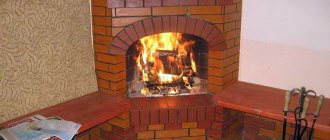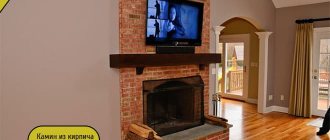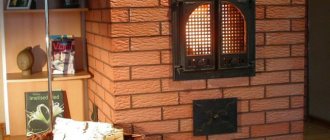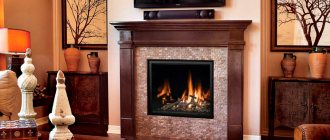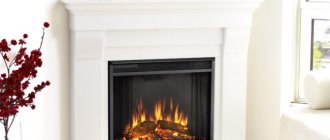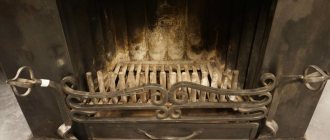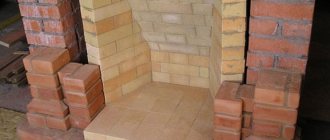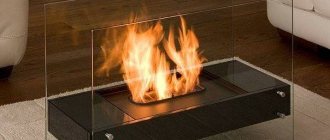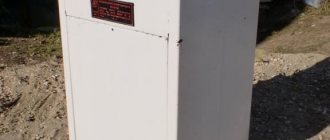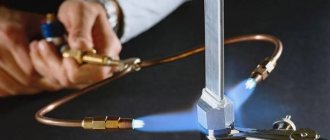You can actively use false fireplaces as a decorative element for your apartment. They are designed to bring comfort into the home, create an aura of calm and homeliness around themselves. At the same time, such a design will certainly become the center of attention, the main accent of the room and the attraction of your interior.
There are plenty of options for making an artificial fireplace; you can choose a wooden, plasterboard, stone or even cardboard option, or you can install a fireplace made of polyurethane. In this article we will talk in detail about portals for fireplaces made of polyurethane, consider the intricacies of handling such a material, its advantages, and study the practice of creating false fireplaces from polyurethane with your own hands.
Original white false fireplace in the bedroom
Manufacturing procedure
So, you have decided on the type of fireplace to choose, you have decided in which part of the apartment it will be installed, and now you are planning to make a portal for it.
To begin with, we prepare detailed drawings on which we indicate the dimensions of all elements of the portal and calculate the amount of materials required for construction. Take into account all the nuances and double-check the received data several times - this is much easier than redoing something during the design process. Step-by-step instructions for making a fireplace portal with your own hands. Let's look at an example of constructing a plasterboard portal for an electric fireplace.
- In the chosen location of the fireplace, transfer a drawing of its main elements to the walls and floor;
- Build a frame from a metal profile (it is recommended to use a guide and rack profile), attach it to the wall;
- Next, build a so-called “podium” from the profile - the bottom of the portal, after which you can form the frame of the portal itself with a firebox. The frame must be reinforced; for this, every 15-20 cm across its entire area we fix transverse beams from a rack profile;
- We insert our electric fireplace into the prepared box. Such a preliminary “fitting” is very important, since at this stage of construction there is still an opportunity to correct possible flaws, for example, if the fireplace fits tightly, then you need to increase the size of the firebox - unscrew the profile, move it to the required distance and screw it on again;
- Before covering the frame with sheets of plasterboard, you will have to make holes in them yourself on the inside of the portal opposite the exhaust ducts in the body of the electric fireplace;
- The next stage is covering the box with sheets of plasterboard. Use self-tapping screws no longer than 2.5 cm and fine thread, preferably black. It can be sheathed in either one or two layers - it depends on the choice of materials for decoration. A simple decor can be made with a single layer of cladding, while a complex one (for example, decorating a portal with artificial stone or plaster stucco) will require a double layer;
- We take a deep penetration primer and thoroughly saturate the entire plasterboard surface;
- Before applying decorative elements, the surface of the portal must be covered with a layer of putty; to protect the corners, choose a perforated corner profile;
- Your further actions depend on the chosen decoration method. If you are going to paint your portal, sand the surface until it is perfectly smooth, then paint. If your goal is to cover the portal with tiles or other decorative elements, then simply glue them onto the prepared surface using special glue;
- On top of the portal, a so-called mantelpiece is built from a double layer of plasterboard - this is where you will place your photo frames and other trinkets. Since it will bear a certain load, it is necessary to strengthen it with an additional profile and attach it to the wall. Visually, the shelf should look one with the overall design of the portal;
- For a more impressive look, you can complement the portal design with sidewalls and a foot, which are made using plaster finishing, stone or other materials for decoration.
The above step-by-step plan for installing a portal for an electric fireplace is also suitable for making a false fireplace, however, it will require additional decoration in the form of a mirror on the back wall, imitation fire, beautifully stacked firewood in the hearth, etc. Your imagination will be your best assistant at this stage of finishing.
10photos
Installation of polyurethane
First, you need to fully imagine a polyurethane fireplace
Before starting work, craftsmen advise keeping the material in the room where the fastening will be carried out during the day. Elements must adapt to temperature conditions.
Preparing the plane
For high-quality fastening, the portal plane must be prepared:
- the surface must be dry and clean;
- the surface for fastening must be flat;
- painting and coating of the surface should be carried out after installation of polyurethane elements;
- create a drawing on paper and lay it out on the floor before starting installation.
Preparing the tool
In order not to be distracted during work, you should prepare the necessary tools in advance:
- to saw the elements you will need a miter box;
- small tooth saw or hacksaw;
- roulette;
- To connect the elements together, you will need joining glue;
- to fasten the elements to the plane, you will need mounting adhesive;
- To apply glue you will need a spatula;
- to remove dried glue you will need fine-grained sandpaper;
- drill.
Options for decorating a false fireplace
Traditionally, an artificial fireplace is decorated with real or decorative logs, but modern interior design trends allow you to move away from tradition and use the most daring ideas and non-standard solutions for decoration.
Electric fireboxes – modern and authentic
Electric fireplaces of the latest generation can operate in decorative flame mode without heating up at all. Modern systems for simulating fire are almost impossible to distinguish from real combustion unless you set yourself the goal of detecting a fake.
Ultra-thin Electrolux electric fireplace 9 cm deep
The effect of a realistic flame is achieved using LED lighting and a steam generator - illuminated steam rushing upward creates the effect of real combustion with an intense flame at the bottom, disappearing at the top of the firebox.
Luxurious home fire without dangerous fire
Design ideas for a conventional firebox
To prevent a decorative polyurethane fireplace from turning into an empty frame on the wall, you need to highlight the firebox. To do this, use materials that imitate brickwork, tiles, and paint. The mirror wall looks very original, visually increasing the depth of the combustion hole.
Imitation of brickwork with tiles
The mirror wall makes the firebox deeper
There are no strict requirements for the design of the firebox of a conventional fireplace - you can leave it white if the wall is painted white. However, it is recommended to work on a section of the wall if other shades, textured wallpaper, decorative plaster, or panels were used to decorate it.
How to decorate the interior of a fireplace
LED candles are a stylish and safe decoration for a symbolic home. A flickering imitation flame softly illuminates the room, creating the effect of a scorching fire. Candles are placed on shaped candlesticks, creating a semantic composition, or placed chaotically.
Corner home hearth decorated with candles
Some designers make two or three shelves inside the firebox for decoration - souvenirs, figurines, books, potted plants, artificial flowers and fruits. Unusual details for real stove equipment do not spoil the conventional fireplace, organically complementing the designer decor.
The mantelpiece is the main detail of an English-style hearth. It is used to place photo frames, boxes, and decorative items. An excellent solution is to hang a picture, mirror or flat-screen TV over a conventional fireplace.
Imitation of a hearth in the interior
You don’t need to see a polyurethane fireplace as just an imitation of a real hearth. People have long since switched from horses to cars, to using running water and cooking in electric ovens. Why not get yourself this stylish decoration that will fill your home with comfort and warmth. If the installation seems complicated, entrust all the “dirty” work to specialists.
What else can you fill the firebox with?
But if you don’t want to constantly admire the dancing flames, then you can leave only decorative functions to the fireplace. Or use it for other practical purposes. At first glance, the fireplace has only two uses. In fact, everything is limited only by the riot of imagination.
False fireplace decorated with a mirror Source remont-samomy.ru
Here is a giant list of how you can use the firebox of a false fireplace:
- Lay out the wood as for a fire. You can add a little bit of everything to the logs.
- Figurative dry branches, candle lanterns and even indoor green plants.
- Lining the inside of a fake fireplace with ceramic tiles will increase its appeal. In addition, you don’t have to worry about ignition from a burning candle.
- But if the fear of fires remains, then burning candles can be placed in separate cases. Several lanterns of different sizes in the firebox will look very original.
- If you use low candles and place each one on its own small log, you can even create a festive atmosphere.
- During the Christmas season, it is good to complement the hearth with candles with fir branches.
- Using fireplace paraphernalia, you can further embellish the fake decor. For example, place dry ikebana in a poker bucket. Place a firewood stand inside the fireplace and place candles on it.
- If you rank items, you can get an original effect. In the hearth, candles are placed on stands, in glasses, or just like that.
- You can install a work of art in the fireplace portal - a small painting or figurine.
- A thematic poster surrounded by decorative bottles will look more than original.
- If the false fireplace turns out to be massive, then it can be used instead of a cabinet. In this case, a good solution would be to place a chest for things inside the portal.
- The bookshelves inside the fireplace look extraordinary.
- When the decoration is installed in the kitchen, it can perform practical functions. A rack is installed in the portal, and dishes or jars of spices are stored on its shelves.
- Children rarely have such decor. But if it is already there, then a dollhouse can fit inside. Or the hearth becomes a storage area for toys.
- It is symbolic to close the portal with a door. It will act as an entrance to the magical world.
- If there is a large toy animal, then the firebox can serve as a kennel.
- Both the mantelpiece and the shelving unit inside the hearth will help to display a collection of figurines or objects.
- A giant letter or a whole word will look quirky in the fireplace.
- A wicker basket works well for a rustic look. You can put anything inside. From chopped firewood to imitation of the harvest.
- The firebox filled to the top with pumpkins of various sizes looks extraordinary.
- A false fireplace in the kitchen will attract attention and fulfill a practical role if a hob with oven is installed in it.
- A large vase with dried or artificial flowers looks beautiful.
- Place a wine bar eccentrically in the firebox.
- The watering can for watering plants inside the fireplace looks unusual.
- Super original - hide the air conditioner in the fireplace niche.
And the classic option would be a hearth filled to the very top with firewood. The logs can even be painted. Moreover, you need to use colors that predominate in the interior of the room.
Types and methods of production
Artistic stucco represents figured and relief ornamental patterns of architectural decor. Stucco molding decorates ceilings, walls, door and window openings, allowing you to make any surface the dominant detail of the interior. No less popular is decorating the portal of a home fireplace - the heart and soul of the room - with stucco.
Methods of stucco production:
- manual (simulation);
- production (molding, casting).
The production method involves the production of individual parts of stucco molding using casting or pressing. Hand modeling requires the search for a craftsman (an artist and a professional modeler), sufficient financial investments and labor costs, but it allows you to obtain a decor whose design will be exclusive.
Exquisite stucco for a fireplace in a country house in southern Austria.
The fireplace panel is decorated using plaster stucco.
Components of the stucco molding of the fireplace portal:
- cornices (with ornaments and smooth profile);
- capitals and brackets (supports);
- pediments (the upper parts of the composition in the form of a triangle);
- moldings (convex relief strips);
- columns and pilasters (half-columns, three-quarter columns);
- base (pedestal);
- friezes (ornamental compositions);
- decor (ornaments, statues, corner elements, overlay panels, panels, frescoes, caryatids).
Living room in Art Nouveau style with a large fireplace decorated with decorative stucco.
Designer stucco molding in the Baroque style decorates the fireplace in the country mansion of a Moscow businessman.
What can you make a decorative fireplace from?
Craftsmen have come up with many design options for false fireplaces. We present to your attention an overview of the most popular of them.
Brick
Decorative brick fireplace
This material allows you to bring the design of the decorative structure as close as possible to the appearance of a real fire. The false fireplace is laid out from decorative or facing bricks for jointing.
Anyone who has at least once encountered masonry work can handle this activity. However, you must first make sure that the existing floor can support the weight of the finished structure, especially if it has large dimensions.
laminated chipboard
We draw sketches We prepare laminated chipboard for work Parts of a false fireplace We assemble the fireplace, fastening the parts with self-tapping screws The fireplace is almost ready The fireplace is almost ready We line the fireplace with foam bricks and cover it with a lid
Laminated boards and other similar materials are perfect for decorating false fireplaces.
In order for the structure to have a neat and attractive appearance, it is necessary to thoroughly prepare for the upcoming work. Preparation comes down to creating a drawing indicating all the dimensions of the future false fireplace. Based on this drawing, you can order cutting of the slabs from a specialized company, or you can do it yourself if you have the required skills.
If you want to save money, laminated boards can be replaced with a more budget-friendly analogue - chipboard. After assembling the structure, you can decorate it at your discretion.
Polyurethane
Polyurethane decor
Products made from polyurethane are used mainly to decorate ready-made structures. However, if desired, all kinds of moldings, platbands and half-columns can be glued directly to the wall. Such a design will not look like a full-fledged fireplace, however, special decorative techniques will allow you to benefit from the portal, making it look like a real fireplace.
False fireplace
Drywall
Drywall DIY decorative fireplace
This material is most often used to decorate false fireplaces. Drywall is characterized by extreme ease of assembly and goes well with a wide variety of finishes. From sheet material you can create spatial forms of almost any complexity. At the same time, the cost of drywall makes it accessible to a wide range of buyers.
Sheet construction requires mandatory finishing. But this is rather an advantage of the material, rather than its disadvantage - over time, the cladding can be changed without dismantling the decorative portal itself.
Beautiful fireplace made of plasterboard with an unusual plaster finish
Connection diagrams for photo relays for street lighting
The main function of the photo relay is to supply power at nightfall and turn it off at dawn. Thus, it is an automatic switch that operates without human intervention. The role of the shutdown button is played by a photosensitive element. The photo relay connection diagram is similar: a phase is supplied to the device, it is interrupted at the outputs, and if necessary, the circuit is closed, as a result of which voltage is supplied to the lamps or spotlights.
To ensure the operation of the photo relay, power is also required, so a zero is connected to certain contacts. Since the lighting is supposed to be in an open area, there is a need for a ground connection.
It is important to correctly connect the conductors coming out of the body of the regulator itself with the lamp and the network
Unfortunately, there is no universal connection diagram that would fit all types of photo relays, but certain points are typical for all operations. They must be taken into account, especially if you install a photo relay with your own hands.
In almost all models, the output relay has three multi-colored wires that correspond to the following designations:
- black – phase;
- green – zero;
- red – phase commutating to the light source.
To provide additional functions, you can purchase photo relays with motion sensors or timers
Step-by-step instructions for connecting photo relays for street lighting
The instructions below will tell you how to connect the photo relay step by step, quickly and correctly:
- Pre-installation of the distribution panel. It is usually mounted on the wall, and conductors are connected in it.
- Connecting the photo relay according to the diagram, which is in the technical documentation attached to the device itself. Usually a bracket is used as a fastener. It is installed in a place where the relay will receive direct sunlight, but other light sources are isolated.
- Adjusting the system using a controller, that is, selecting the parameters for the device’s response to specific conditions of lighting changes.
- The regulator is installed on the external part of the device with the corresponding technical characteristics: sensitivity range – 5-10 lm; power – 1-3 kW, permissible current threshold – 10A.
If the device is mounted in the middle of an electrical panel with a complex design, where the sun's rays do not penetrate, then the relay and switch are installed separately from each other. The parts of the device are connected to each other with special cables.
The photo relay is connected according to the diagram, which is in the technical documentation attached to the device itself
When installing street lighting, it is recommended to follow the following rules:
- It is better to place a device with an external photocell in such a way as to exclude direct light from the installed lamp. Otherwise, the device will work with errors.
- To check whether the circuit is connected correctly or not, you need to connect the starter to the mains. The result will be clear when the lamp is activated.
Nuances in light sensor connection diagrams
The fact that the photo relay is selected taking into account the expected load may affect the cost of the product: depending on the power, the price increases. Therefore, in order to save money, it is possible to provide power supply not through a photosensor, but through a magnetic starter. This is a special device designed for frequent on/off operation. Using a trigger mechanism allows you to connect power using a photosensitive element with minimal load.
Thus, in fact, only the magnetic starter is turned on, so only the power consumed by it is taken into account. But at the terminals of the magnetic starter it is possible to use a more powerful load
In order to save money, you can provide power supply not through a photosensor, but through a magnetic starter
In the case when, in addition to the day/night sensor, it is necessary to connect devices with additional functions, for example, a timer or motion sensor, they are installed after installing the photo relay. In this case, the order of priority of additional devices is unimportant.
If a timer or motion sensor function is provided in the structure of the device, but it is not needed in a particular case, then these devices are simply excluded from the general circuit, that is, no wires are connected to them. In this case, if necessary, these elements of the device can be connected.
Choosing the style of stucco molding
In order for the frame with the hearth to look as harmonious as possible and fit best into the overall interior and design of the living room, we recommend that you familiarize yourself with the following features and criteria for choosing such a finish:
- Classic performance. Allows you to simulate a stone surface. Fireplaces made of stucco take on the most natural appearance and natural structure;
- Stucco molding in medieval style. Presented with large and textured elements and three-dimensional images;
- Antiquity and antiquity. Such decoration will give the installation a medieval design and mystery. The main technique of such execution is the aging of the surfaces of finishing materials.
Decorating the fireplace shelf for the New Year and Christmas
Decorating the fireplace shelf for the New Year and Christmas
Massive portal in the classic design of a small living room
Massive portal in the classic design of a small living room
You can learn more about these trends and decoration features by watching the video in this article.
Classification of stucco
When choosing gypsum and other stucco molding, you must first carefully familiarize yourself with its classification and characteristic features of application:
- Using polystyrene foam as stucco molding. This method is one of the simplest and most cost-effective. The low cost of this design is achieved due to the availability of polystyrene foam. This material is distinguished by its good flexibility and ease of processing. This makes it possible, if necessary, to bend it, thereby giving it a certain shape, or to cut out any, even the most complex elements. The disadvantages of such material include its fragility;
- Plaster stucco. The cost of such coverage is quite high. However, this material has a lot of unique advantages. It is distinguished by its durability, environmental friendliness and high strength. The design is made of plaster and will last quite a long time. In addition, gypsum has good fire-resistant properties and is perfect for both partial and complete decoration of portals;
Plaster molding for a fireplace: classic frame, for subsequent installation of an electric fireplace
Plaster molding for a fireplace: classic frame, for subsequent installation of an electric fireplace
Decorative base made of polyurethane
Decorative base made of polyurethane
Purchased frame with plaster elements and natural stone trim
Purchased frame with plaster elements and natural stone trim
Choosing stucco elements
First of all, you need to decide on the style and method of decorating the hearth.
It is equally important to take the operating conditions of the heating unit as a basis. It can serve both a purely decorative function and efficiently and fully heat the entire house or apartment.
Also decide on the type of hearth itself; it can be one of the following varieties:
- Electric. Allows you to simulate real fire using three-dimensional images and sound effects. It has several levels of power adjustment and operating methods. Operates from a standard electrical network;
- Classic wood-burning. Suitable for installation in private homes. A real flame burns in the hearth; logs and coals are used as the main fuel. Installation requires installation and installation of a chimney.
Gypsum stucco molding in loft style
Decorating the frame and adjacent walls in a single style
A beautiful and voluminous portal with an abundance of stucco: the work of a professional craftsman
In order to familiarize yourself with the cladding options in more detail, we recommend viewing the photos in this article.
DIY decorative New Year's fireplace: step-by-step instructions
After all the constituent elements are ready, the most intriguing part of the work begins. The intrigue is that if miscalculations were made at the previous step, then at the assembly stage the structure will not be assembled into a single component and some elements will have to be cut out again.
DIY false fireplace: materials
Assembling the back wall
The back wall in my case consists of 2 elements; it so happened that we were unable to cut out a part 95 cm wide and 115 cm high into a single component. But this is not a problem, because... you can fasten 2 boards together using a block, and fill the joints between the boards with decorative plaster, which was left in our house after the renovation.
The process of assembling the back wall for the fireplace
Sequence of work:
- We saw the bars to attach the back walls to them;
- We fasten the rear walls with self-tapping screws;
The back wall is ready
Attach the side ribs to the back wall
We've sorted out the back wall, pay attention to the previous photo, I deliberately left a few centimeters on the sides in order to attach the side ribs to the back wall end-to-end. The operation sequence is also quite simple:
- We screw the side ribs to the bars using self-tapping screws.
- We screw additional bars to the side ribs to secure the front wall and lid.
The back wall and side ribs are screwed
Assembling the front (front) side of the fireplace
The front side consists of 4 components, including:
- Front upper beam;
- Two sides;
- Bottom beam;
The width of the “firebox” opening is 35 cm wide and 40 cm high
Please note that later I slightly regretted the small dimensions of the hole in the fireplace, so I suggest you increase the firebox hole to 40 by 40 cm or 40 by 50 cm
this will give a more aesthetic appearance to your fireplace.
Prices for decorative fireplace
decorative fireplace
Please note that in order to secure our hole with the “firebox” we will have to attach 4 bars to the back cover, and attach the inner walls to them. The process of assembling the front side of the fireplace
The process of assembling the front side of the fireplace
Go ahead. The front side is almost ready, the next step is to attach the front side to the side wall.
Attaching the front side of the fireplace to the frame
Attach the top cover to the fireplace frame
Well, the frame is almost ready with the exception of some details. What is missing? Right! The top cover is missing. This is what needs to be attached. The dimensions of the top cover differ from the dimensions of the fireplace, because... it should protrude 5-10 cm from all sides. Its size is 100 cm wide and 25 cm high. Next, consider an example of its attachment to the frame in the photo below.
The fireplace frame has been successfully assembled
The frame of our decorative fireplace is assembled. The next stage is its decorative design. In fact, the decorative design of a fireplace is the topic of a separate article in which all the points need to be described, but for your convenience, I will try in this material to reflect all the main points on decorating a fireplace.
No. 6. Tiles
Tiles are, in fact, the same terracotta tiles or majolica. The difference lies in the special structure. The tiles have a rumpa, a square hollow projection that holds the tiles in place during installation. Rumpa is also important for another purpose - it helps to retain heat. Tiles can be used to decorate a fireplace only during its laying. If the moment is missed, you will have to choose another finishing method.
Tiles have the same advantages as tiles. The choice of colors is huge, there are very sophisticated samples that will bring special chic to the interior.
Installation of tiles is carried out in this way:
- The pump is filled ½ full with a mixture of clay and broken bricks, and the so-called crutch, thick (5 mm in diameter) wire with a bend at the top;
- a flexible soft wire is attached in the middle of the crutch, which will later be embedded in the brickwork;
- the pump is filled to the brim with clay mixture;
- As the laying progresses, the tiles are installed and the wire is hidden in the seam. The individual parts are connected to each other using U-shaped brackets.
It is difficult to do such installation yourself, which makes installing a fireplace a more expensive pleasure. In addition, the material itself is more expensive than regular tiles.
Styles of polyurethane fireplaces
Polyurethane replicas of portals are made taking into account the styles of real fireplaces. However, not all areas of architecture and design are represented in polyurethane.
These are mainly classical portals, in the Baroque, Rococo and Empire styles.
Classical. The style is characterized by straight repeating lines, symmetry, columns with paths. The creators were inspired by ancient Greek and Roman architecture, so the fireplace columns here are decorated with antique ornaments, there are bas-reliefs and pilasters.
Portal for a fireplace in a classic style
Baroque. This style is characterized by curved lines, ornateness, an abundance of stucco molding, decorations, arches and columns, decorated with lush and elaborate capitals.
Rococo. It is easy to confuse it with Baroque, since the style arose from it and is not much different. These are all the same curved graceful lines, a lot of decorations, bas-reliefs and pretentiousness. However, Rococo is a freer, more playful style, devoid of pomposity. Its elements are decorated with flowers, garlands of fruit, wreaths, and monograms. There are figurines of fat angels, kissing lovers, etc.
Empire style portal
Empire style The style of the times of Napoleon, when the main task of artists was to praise the victories of the empire (empire - empire). The style is similar to the classical one, since it also originates in antiquity, but it is characterized by its most pompous sides. Stucco molding in the form of triumphal wreaths, ribbons, cups, heraldic symbols, coats of arms, eagles, lions. Everything about this style exudes victoriousness.
If you decide to purchase an electric fireplace, you need to think about decorating it, because such a device itself does not look very aesthetically pleasing. Do-it-yourself portals for fireplaces - read designers’ tips on making.
You will find instructions for making a brick fireplace with your own hands here.
